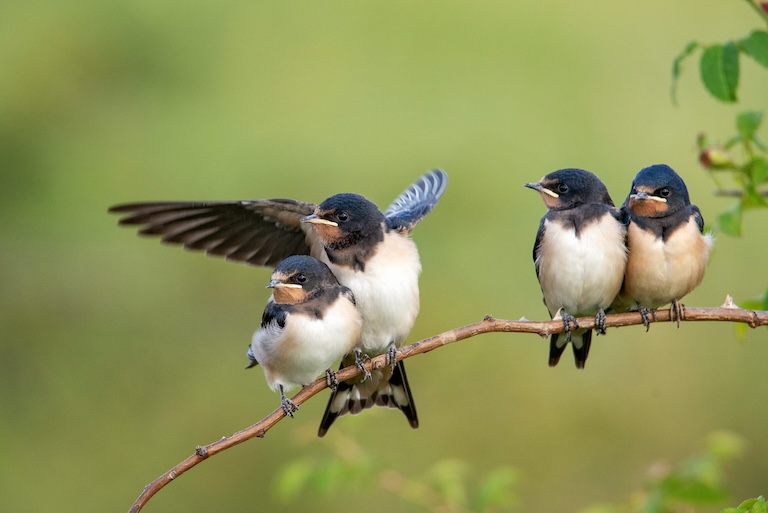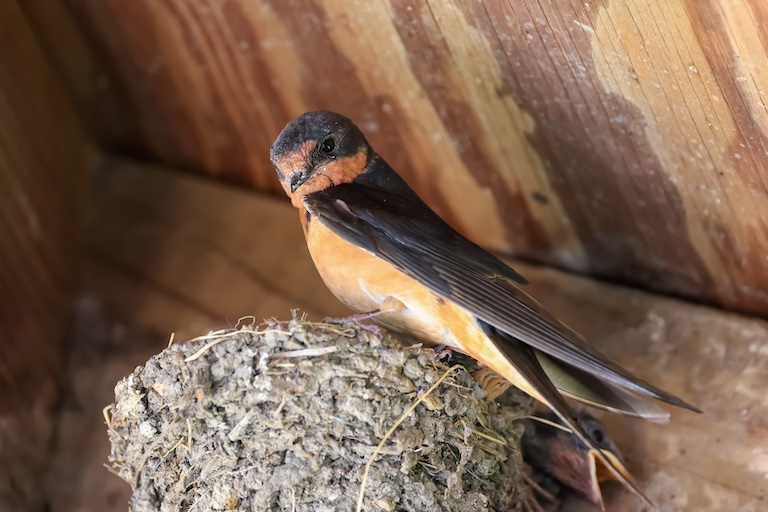Barn Swallow Profile
With a name like a Linda Lovelace movie, The Barn Swallow is at least twice as well known and much more widely accepted.
This is the apocryphal unladen European bird; the subject of riddles that sent so many to their demise on the bridge of death; though this animal’s range spans significantly farther than its name would suggest – far from the familiar mud nests clinging to barn soffits, these birds have more or less taken over the world.

Barn Swallow Facts Overview
| Habitat: | Open country with low vegetation, near water, from farmland to savanna |
| Location: | Worldwide even occasionally in polar climates |
| Lifespan: | 8 years |
| Size: | 17 to 19 cm (6 1⁄2 to 71⁄2 in) long |
| Weight: | 16–22 g (9⁄16–3⁄4 oz) |
| Colour: | Steel blue upperparts and a rufous forehead, chin and throat |
| Diet: | Mostly flies, some Hemipterans, ants, and other arthropods |
| Predators: | Mostly raptors, cats |
| Unladen airspeed velocity: | 72 km/h (45 mph) |
| No. of Species: | 1 |
| Conservation Status: | Least Concern |
Barn swallows are one of the most populous vertebrates in the world, and also one of the most widespread. They’re aerial acrobats, highly adapted to life on the wing, which is where they feed, socialise and explore.
They’re one of around 90 species of swallow, and at least 16 in their genus, known for their impressive migrations and adaptivity to a multitude of open habitats.
While they are well endowed in number, for now, their global population is dropping – a consequence of the monopoly humans have over terrestrial real estate.
Interesting Barn Swallow Facts
1. They’re songbirds
Swallows are almost immediately recognisable as the fork-tailed aerial acrobats catching insects on the wing. They’re members of the Passerine order of birds, also called the perching birds, which is a little ironic, considering how little time this species spends on its feet.
The suborder Passeri groups the so-called songbirds, and swallows are from a family inside this, known as Hirundinidae, which also contains the saw-wings and martins.
Most in this family are from Africa, which is thought to be where the family evolved to nest in holes, but while the Western and Southern African species stay put year-round, the European species, including the barn swallow, travel incredible distances.

2. They migrate
Unlike coconuts, which typically need to be carried by a pair of fully laden swallows, the unladen European swallow makes its own way between continents.
Swallows ringed in Britain have shown up all the way down in South Africa, and this is just one example of the barn swallow’s incredible voyages.
In most widespread species, it’s common to say they’re found “Worldwide, except Antarctica”. This is true for ants, bees, otters, mosquitos and even cockroaches, but not true for the barn swallow.
Vagrants have shown up on Hawaii, Greenland, the Falklands and Antarctica, and it appears there isn’t a corner of the globe they won’t explore. 1
3. They’re social
Barn swallows are often seen in enormous groups, quite stereotypically all lined up on a telephone or power line in a rural part of the country. They like to nest this way, too, and appear to communicate vocally with one another.
Calls include songs that are personal to the individual, as well as songs that are designed to be reciprocated, and pairs will often ‘duet’ together or sing in groups as a chorus. 2
4. They team up with ospreys
These birds are so social they’ll even hang out with animals you’d think would want to eat them.
The charismatic osprey, another cosmopolitan animal, is one of their neighbors of choice, sharing a nesting area with the species on purpose and forming a mutually beneficial relationship in which the giant osprey keeps the smaller raptors away and the swallows with their keen eyesight and huge numbers, help to identify and sound the alarm for threats in return. 3
5. They’re widespread
Perhaps the most impressive thing about this species is just how widespread they are.
As we mentioned, vagrants show up almost everywhere, but to put it into perspective, the Passerines are the most diverse order of birds, containing more than 60% of all species, and this little swallow is likely to have the largest natural distribution of them all.
This means that they aren’t being introduced to these remote locations, like the rats in New Zealand or the Gray squirrels in Europe, these actually belong all over the world.

6. They’re incredibly adaptable
The key to being a cosmopolitan is being able to adapt to new conditions, and the barn swallow is certainly more than able in this regard.
It prefers open country where it can spot and catch plenty of food, but within this lone caveat, it’s comfortable over almost all climates and altitudes.
It breeds in farms, cities, on savannas and cliffs, and feeds almost exclusively on flying insects wherever it chooses to stay.
7. They’re decreasing
With a human population of around 8 billion, it’s easy to forget that these numbers are more or less unheard of in terrestrial vertebrate species (and this is not a healthy sign).
So, a population of up to 487 million birds, as estimated by the IUCN, is an incredible statistic, and even the lower bound of 290 million makes them one of the most populous vertebrates on Earth.
But the barn swallow, while still incredibly populous, is in decline, and this is a testament to the far-reaching effects of human destruction. Intensive farming is the major component of the destruction of the habitats of swallows, as previous farming practices still provided foraging zones for the birds.
Today’s industrial farming involves vast monocultures of almost sterile land, and the toxic blankets of pesticides leave little room for any life other than the target crop or livestock. More automation means fewer buildings and fewer nest sites, and all of this amounts to a drop in biodiversity.
The species is still so numerous it will be a long time before it’s a conservation concern, but the red flags of such an incredibly adaptable animal to be suffering from human development should be obvious already. 4

Barn Swallow Fact-File Summary
Scientific Classification
| Kingdom: | Animalia |
| Phylum: | Chordata |
| Class: | Aves |
| Order: | Passeriformes |
| Family: | Hirundinidae |
| Genus: | Hirundo |
| Species: | rustica |
Fact Sources & References
- Małgorzata Korczak-Abshire (2011), “First documented record of barn swallow (Hirundo rustica) in the Antarctic”, Research Gate.
- Tanya Dewey, “Hirundo rustica barn swallow”, Animal Diversity Web.
- (2019), “Barn Swallow”, Fauna Focus.
- “Barn Swallow”, IUCN Red List.
